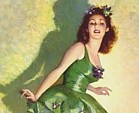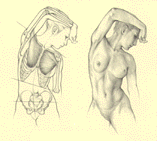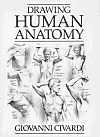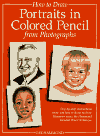 Figures in Action
and
Heads/2
by Andrew Loomis are part of the
well-known Walter Foster series of skinny art books, and they reprint
some of Loomis’s art instruction from the 40s. This means that some of the
hairstyles and clothes may appear dated
(although clothes don’t appear all
that often),
Figures in Action
and
Heads/2
by Andrew Loomis are part of the
well-known Walter Foster series of skinny art books, and they reprint
some of Loomis’s art instruction from the 40s. This means that some of the
hairstyles and clothes may appear dated
(although clothes don’t appear all
that often),
 but the face and figure remain timelessly the same, and
breathtakingly rendered by Loomis.
Let’s put it this way: the mighty
Steve Rude
swears by Loomis and claims that this is where he learned to draw people.
How much higher recommendation could you want?!
but the face and figure remain timelessly the same, and
breathtakingly rendered by Loomis.
Let’s put it this way: the mighty
Steve Rude
swears by Loomis and claims that this is where he learned to draw people.
How much higher recommendation could you want?!What’s that you say? “Loomis isn’t realistic enough”??!! Then allow me to point you to the most amazing figure drawing books I’ve yet seen: Drawing the Human Head: Techniques and Anatomy and How to Draw the Human Figure : An Anatomical Approach by Louise Gordon.
Seems to me that artists’ anatomy books often fall into two ruts: either, one, they teach a stylized, shortcut anatomy that will inevitably fail you at some crucial point cuz you “never learned that pose”, or, two, they will be witheringly accurate but also be filled with stuffy, pre-20th century, Gray’s Anatomy kind of drawings which in comics would look weird and wrong.
 Louise Gordon miraculously avoids both pitfalls. She obviously knows the medical
side of human anatomy inside-out
Louise Gordon miraculously avoids both pitfalls. She obviously knows the medical
side of human anatomy inside-out  , but much of that
you can skim if it feels too much like homework, there won’t be a test.
She gently shows you how the inner anatomy shapes and affects the visible surface,
in a way teaching you to figure out what any angle will look like. She divulges
a number of excellent tips and pointers I’ve never seen elsewhere, and her drawings
look fresh, contemporary, and really alive, totally avoiding that medical illustrator
mustiness. Gordon’s work was a revelation for me, and if you’re heavily into drawing
the human form as realistically as possible, I can’t recommend these highly enough.
, but much of that
you can skim if it feels too much like homework, there won’t be a test.
She gently shows you how the inner anatomy shapes and affects the visible surface,
in a way teaching you to figure out what any angle will look like. She divulges
a number of excellent tips and pointers I’ve never seen elsewhere, and her drawings
look fresh, contemporary, and really alive, totally avoiding that medical illustrator
mustiness. Gordon’s work was a revelation for me, and if you’re heavily into drawing
the human form as realistically as possible, I can’t recommend these highly enough. Here’s another really good anatomy book with a
slightly different slant than Gordon’s works:
Drawing Human Anatomy by Giovanni Civardi.
Where Civardi’s finished drawings may exhibit slightly less finesse than
Gordon’s, and is missing a few of her valuable tips, Civardi gains points
for thoroughness. What I found to be the most impressive part of his
book is what amounts to a “Guided Tour of the Head”. There’s a section where
he isolates and identifies every muscle of the face and head [i.e.,
a lot of ’em!] -- and he accompanies it with a drawing showing
what the surface of the face and head look like when that muscle is
being used! Some muscles make facial lines, others are subtler and only
make little “waves” in the skin -- Civardi guides you through all
of ’em.
A truly awesome resource for the comic-book realist!
Here’s another really good anatomy book with a
slightly different slant than Gordon’s works:
Drawing Human Anatomy by Giovanni Civardi.
Where Civardi’s finished drawings may exhibit slightly less finesse than
Gordon’s, and is missing a few of her valuable tips, Civardi gains points
for thoroughness. What I found to be the most impressive part of his
book is what amounts to a “Guided Tour of the Head”. There’s a section where
he isolates and identifies every muscle of the face and head [i.e.,
a lot of ’em!] -- and he accompanies it with a drawing showing
what the surface of the face and head look like when that muscle is
being used! Some muscles make facial lines, others are subtler and only
make little “waves” in the skin -- Civardi guides you through all
of ’em.
A truly awesome resource for the comic-book realist! At first,
How to Draw Portraits in Colored Pencil from Photographs by Lee Hammond may seem way outa line for a comic artist. It discusses the wrong drawing media, doesn’t deal with sequential art, etc. But it does go deeply into the subject of drawing the human face -- and it’s hard to deny that facial expression and close-ups play a pretty major role in the drawing of most comics. So this book has a very specialized usefulness for us: it demonstrates a lot of nifty little tricks and observations that make the difference between the stiff, odd mannequin-faces of many comic artists, and living, expressive, flesh’n’blood, convincing people-faces. I know which kind I wanna do....
At first,
How to Draw Portraits in Colored Pencil from Photographs by Lee Hammond may seem way outa line for a comic artist. It discusses the wrong drawing media, doesn’t deal with sequential art, etc. But it does go deeply into the subject of drawing the human face -- and it’s hard to deny that facial expression and close-ups play a pretty major role in the drawing of most comics. So this book has a very specialized usefulness for us: it demonstrates a lot of nifty little tricks and observations that make the difference between the stiff, odd mannequin-faces of many comic artists, and living, expressive, flesh’n’blood, convincing people-faces. I know which kind I wanna do.... 